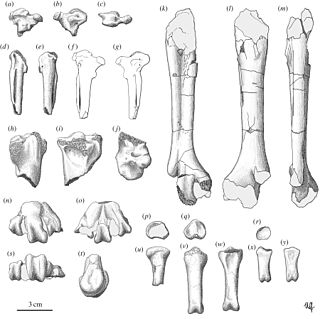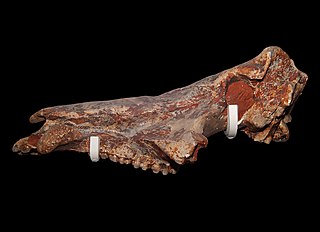
Rails are a large, cosmopolitan family of small- to medium-sized terrestrial and/or semi-amphibious birds. The family exhibits considerable diversity in its forms, and includes such ubiquitous species as the crakes, coots, and gallinule; other rail species are extremely rare or endangered. Many are associated with wetland habitats, some being semi-aquatic like waterfowl, but many more are wading birds or shorebirds. The ideal rail habitats are marsh areas, including rice paddies, and flooded fields or open forest. They are especially fond of dense vegetation for nesting. The rail family is found in every terrestrial habitat with the exception of dry desert, polar or freezing regions, and alpine areas. Members of Rallidae occur on every continent except Antarctica. Numerous unique island species are known.

Anseranatidae, the magpie-geese, is a biological family of waterbirds. The only living species, the magpie goose, is a resident breeder in northern Australia and in southern New Guinea.

Merychippus is an extinct proto-horse of the family Equidae that was endemic to North America during the Miocene, 15.97–5.33 million years ago. It had three toes on each foot and is the first horse known to have grazed.

Desmans are aquatic insectivores of the tribe Desmanini in the mole family, Talpidae.

Ancylotherium is an extinct genus of the family Chalicotheriidae, subfamily Schizotheriinae, endemic to Europe, Asia, and Africa during the Late Miocene-Early Pleistocene, existing for approximately 9.8 million years.

Deinogalerix is an extinct genus of gymnure which lived in Italy in the Late Miocene, 7-10 million years ago. The genus was endemic to what was then the island of Gargano, which is now a peninsula in southeastern Italy bounded by the Adriatic Sea. The first specimens of Deinogalerix were first described in 1972.

Percrocuta is an extinct genus of percrocutid. It lived in Europe, Asia, and Africa, during the Miocene epoch.

Prolagus is an extinct genus of lagomorph. Over 20 species have been named, and the genus was abundant and widespread in Europe during the Neogene. However, by the end of the Middle Pleistocene, it was confined to a single species, the Sardinian pika, on the Corsica, Sardinia, and surrounding islands, where it survived into historical times. In North Africa and Western Asia, the genus is known from the Miocene and Pliocene. The scientific name may mean "before hares" or "primitive hares". Its taxonomy is disputed, with it either being considered a member of the family Ochotonidae, which includes living pikas, or the only member of the family Prolagidae.

Créchy is a commune in the Allier department in central France.
Hesperogavialis is an extinct genus of gryposuchine gavialid. Fossils have been found from Venezuela and Brazil that date back to the Middle to Late Miocene. Although Hesperogavialis is one of the best known gavialoids from South America, the posterior portion of the skull is still unknown, making any attempts at classification within the family somewhat more difficult than other gavialoids in which much of the skull is present. The genus possibly comprises three species. The type species, H. cruxenti, has been found in the Urumaco Formation in Venezuela. A second possible species, named H. bocquentini, has been described from the Solimões Formation in Acre, Brazil, and can be distinguished from H. cruxenti by the asymmetry seen in the anterior portion of the nasals and the small distance between alveoli. A third species can be recognized from the same locality in Acre, although a formal name has yet to be given to it.

Nogodinidae is a family of planthoppers. They have membranous wings with delicate venation and can be confused with members of other Fulgoroid families such as the Issidae and Tropiduchidae. Some authors treat it as a subfamily of the Issidae.

Adcrocuta is an extinct genus of large hyena that lived in Africa and Eurasia during the late Miocene epoch.
Schizodelphis is an extinct genus of cetacean.
The Belgrade Formation is a limestone geologic formation in North Carolina characterized by limestone coquina mixed with sand, and thinly laminated clays. It preserves fossils dating back to the Paleogene period.

Garganornis is an extinct genus of enormous flightless anatid waterfowl from the Late Miocene of Gargano, Italy. The genus contains one species, G. ballmanni, named by Meijer in 2014. Its enormous size is thought to have been an adaptation to living in exposed, open areas with no terrestrial predators, and as a deterrent to the indigenous aerial predators like the eagle Garganoaetus and the giant barn owl Tyto gigantea.

Microstonyx was an extinct genus of suid that existed during the Miocene in Asia and Europe.
Mycteriacetus is an extinct genus of dolphin from the Early Miocene (Burdigalian) of northeastern Italy. The type species is M. bellunensis.
Semigenetta is an extinct genus of viverrid. It lived in Europe, China, and Thailand in the Miocene, and was very similar to the extant genus Genetta, but lacked a molar that Genetta still possesses.
Miomaci is a genus of herbivorous ailuropodine bear from the late Miocene of Hungary. It is known only from teeth and jaws, but these indicate it was significantly smaller than its close relative Indarctos, which could reach 265.74 kg.
Mesopotamocnus is an extinct genus of megalonychid ground sloth that lived during the Late Miocene in what is now Argentina. Fossils have been found in the Ituzaingó Formation of Argentina.














